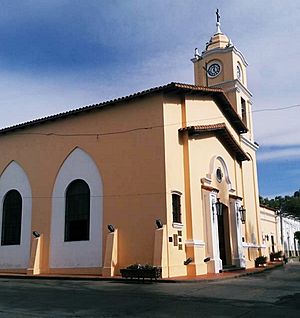Chicoana facts for kids
The Chicoana were an important group of Diaguita people who lived in the Salta Province, Argentina. They were part of the larger Diaguita culture, known for their strong communities and unique way of life in the valleys and mountains of what is now northwestern Argentina.
Contents
Who Were the Chicoana People?
The Chicoana were one of many groups that made up the Diaguita nation. The Diaguita were a large group of native peoples who lived in the dry valleys and mountains of northwestern Argentina. They were known for their farming skills, especially growing corn, beans, and squash. They also raised llamas and alpacas for wool and transportation.
Their Culture and Daily Life
The Chicoana, like other Diaguita, were skilled potters. They made beautiful pottery with geometric designs. They also worked with metals like copper and bronze to create tools and ornaments. Their homes were often made of stone or adobe, built into the landscape.
Their society was organized into different communities, often led by a chief or a council of elders. Family was very important, and they worked together to farm and protect their lands. They had rich spiritual beliefs, often connected to nature and their ancestors.
Where Did the Chicoana Live?
The Chicoana lived in the fertile valleys of what is now Salta Province, Argentina. This region has a mix of mountains, valleys, and rivers, which provided them with resources for farming and living. The specific area they inhabited is often associated with the Chicoana Valley, which still bears their name today.
Their Territory and Environment
The land they lived on was important for their survival. The rivers provided water for their crops, and the mountains offered protection and resources. They understood their environment very well and used it wisely to support their communities. This knowledge helped them thrive for many centuries before the arrival of Europeans.
History of the Chicoana
The history of the Chicoana people is part of the broader history of the Diaguita. They lived in the region for hundreds of years, developing their culture and traditions. They had interactions with other native groups, sometimes trading and sometimes facing conflicts.
Arrival of Europeans
When the Spanish arrived in the 1500s, it brought big changes to the lives of the Chicoana and other Diaguita groups. The Spanish wanted to control the land and its resources. The Diaguita people, including the Chicoana, often resisted these new arrivals to protect their way of life and their lands. This period was challenging for all native groups in the region.
Legacy of the Chicoana
Even though their traditional way of life changed over time, the legacy of the Chicoana people lives on. Their history is an important part of Argentina's heritage. Many towns and places in Salta Province still carry names from the native languages, reminding us of the people who lived there long ago.
Studying the Chicoana helps us understand the rich history and diverse cultures of the native peoples of Argentina. It reminds us of their resilience and their deep connection to the land.
See also
 In Spanish: Chicoana para niños
In Spanish: Chicoana para niños


